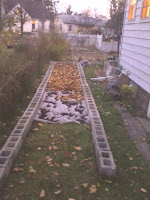The organization I work for is helping small-scale growers in the area to sell their produce at the Farmers' Market we run by supporting a pilot year of an Ypsilanti-based Market Garden Co-operative.
If you're not familiar, a
Market Garden Co-op is a group of smaller growers that would like to sell in a market setting but most likely don't have enough produce to justify having their own stand or stall at the market. Growers can become Members or Sellers, and they basically buy in to the group in order to share a stall space with other small growers. Proceeds from the stall are shared in different ways, and Market Gardeners can pool resources like tables, a tent, chairs, and other infrastructure pieces. The Co-op also shares costs in things like advertising and promotions, so I wouldn't have to have my own business, business name, flyers, etc.

Right now, I am doing one of my favorite things; focusing another
Crazed Project! I've mentioned this tendency in
recent posts- my love of taking on a potentially out-of-reach project and being obsessed with it until I can make it a reality :) The new project on my mind recently has been growing some produce for the market garden co-op!
I've been thinking about growing
carrots for Market, specifically. It seems that we almost
never have carrots available at our Farmers' Market, and they're kind of a staple crop- I mean, people eat a lot of carrots, right? I've heard that carrots are hard to grow, or maybe they're just hard to grow in our soil here in S.E. Michigan. I've had a lot of success with growing carrots at home, and I think I'd have to put some work in to grow market-quality carrots, but it could be very possible!
There are several steps I would need to take in order to prepare for selling at Market:
 |
| Dragon Carrots- High Mowing Seed Co. |
- Select varieties that people would actually like to buy. At first, I was considering all those pretty, colorful types like Dragon Carrots, but maybe those would weird people out?
- I need to think about who the customers are at the market and what type of quality and product they'd be expecting
- I'm beginning to think that the more "regular" and "grocery store" that the carrots look, the more likely they would be to sell
- Soil improvements would need to be made. Carrots supposedly like sandy soil, which I have. I think I'd need to work the soil some, because carrots are pretty sensitive to rocks and things and will take a turn and end up all crooked if they "hit" something as they're growing.
- While its' not necessary, if I invested in some row cover and quick hoops, which I'd like to have anyway, then I could potentially starting selling earlier in the season and sell them later into the fall as well.
Carrots would also be a good option for me to sell at market because I love them, and they store well. So if I don't sell a lot of them, I will be able to eat them up and store them for my own use without feeling like I "lost" money.
Thoughts? Opinions? Advice?













